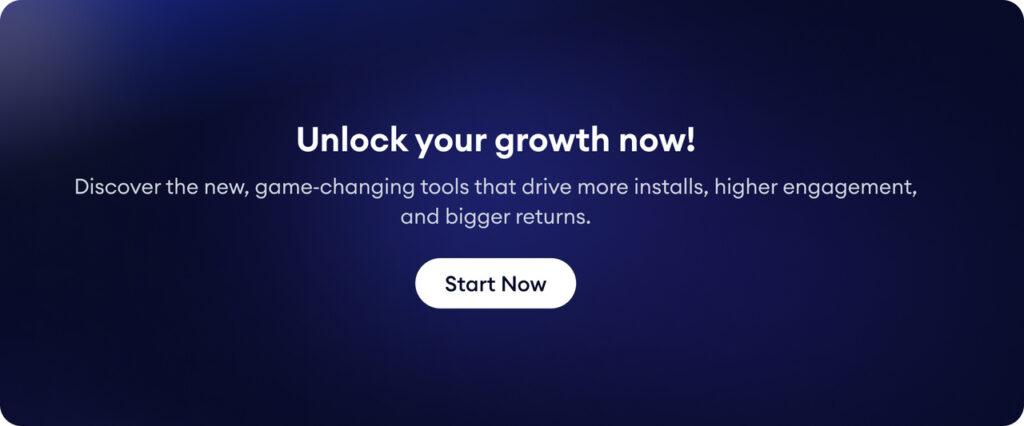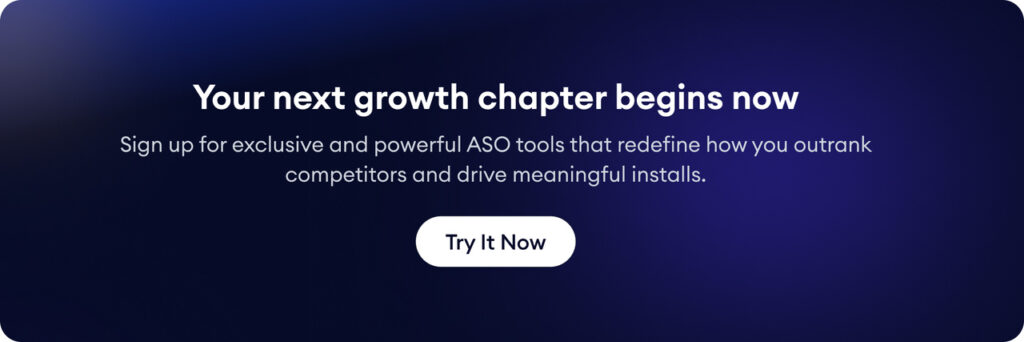App Retailer Optimization (ASO) is a vital a part of any cellular app advertising and marketing technique. With thousands and thousands of apps vying for consideration on the App Retailer and Google Play, standing out and maximizing your app’s conversion price is extra essential than ever.
ASO A/B testing is among the strongest strategies to attain data-driven enhancements in your app retailer efficiency.
By experimenting with completely different app retailer itemizing components and analyzing the outcomes, you may unlock insights that drive extra installs, higher consumer engagement, and even improved retention.
On this weblog publish, we’ll discover what ASO A/B testing is, why it’s essential for app progress, and tips on how to do it successfully.
Whether or not you’re an app developer, an ASO specialist, a marketer, or a consumer acquisition (UA) supervisor, understanding A/B testing for app retailer listings will make it easier to make knowledgeable choices that increase your app’s success.
Let’s dive into the world of data-driven app retailer optimization and learn the way A/B testing can elevate your app’s efficiency.
What’s ASO A/B testing?
ASO A/B testing (App Retailer Optimization A/B testing) is the method of evaluating two or extra variations of your app’s retailer itemizing to see which one performs higher.
In an A/B take a look at, you create two variations (or variants) of a selected app retailer factor (for instance, two completely different app icons or two completely different screenshot units).
You then cut up the viewers or site visitors so {that a} portion of customers see Variant A and one other portion see Variant B. By protecting monitor of key efficiency metrics—sometimes the conversion price from impression to put in—you may decide which variant results in higher outcomes.
In less complicated phrases, ASO A/B testing permits you to ask, “Which model of my app itemizing do customers like extra?” and solutions it with knowledge.
As an illustration, you would possibly take a look at whether or not a blue icon or a inexperienced icon will get extra individuals to obtain your app. Or you can take a look at two completely different screenshots to see which set tells your app’s story extra successfully and convinces extra guests to faucet “Obtain.”
The great thing about ASO A/B testing is that it takes the guesswork out of optimizing your app’s presentation.
Slightly than counting on hunches or subjective opinions about what “seems good,” you make modifications based mostly on precise consumer conduct and preferences.
It’s a scientific method to app retailer optimization: by altering one factor at a time and measuring the result, you be taught what really resonates along with your viewers.
Why ASO A/B Testing is essential
Within the fiercely aggressive app market, ASO A/B testing is essential as a result of it straight impacts key components of your app’s success:
-
Increased conversion charges
Even small enhancements within the conversion price (the share of people that set up your app after viewing it within the retailer) can translate into a big improve in downloads.
A/B testing helps establish which app retailer itemizing components drive extra conversions.
Many app publishers have seen double-digit share uplifts in set up conversion by testing and optimizing visuals and duplicate.
Extra conversions from the identical variety of retailer impressions means you’re getting extra worth out of your visibility.
-
Higher consumer acquisition effectivity
When you’re operating consumer acquisition (UA) campaigns or spending on adverts to drive customers to your app retailer web page, you need to ensure these clicks flip into installs.
A well-optimized, high-converting app retailer web page means decrease price per set up (CPI) on your advert campaigns as a result of a bigger fraction of people that arrive will truly obtain the app.
UA managers love A/B testing as a result of it ensures that your advertising and marketing {dollars} are bringing in as many customers as doable.
Primarily, A/B testing your ASO makes all of your different advertising and marketing efforts more practical.
-
Knowledge-driven determination making
ASO A/B testing fosters a tradition of data-driven optimization. As an alternative of guessing which icon or screenshot could be higher, you’ve got actual consumer knowledge to again up your choices.
This reduces the danger of creating modifications that would damage efficiency.
It additionally typically gives stunning insights – for instance, you would possibly be taught that customers favor a screenshot highlighting a selected function you thought was much less essential.
These insights can inform not solely your ASO technique but additionally your broader advertising and marketing messaging and even product choices.
-
Improved consumer retention (Not directly)
Whereas A/B testing primarily focuses on driving installs, it might have downstream results on retention and consumer satisfaction.
How so? The thought is that by optimizing your retailer itemizing, you set correct expectations for the consumer.
If the screenshots and outline precisely spotlight the perfect components of your app, the customers who set up it usually tend to be happy with what they get.
For instance, in case you uncover through testing that showcasing a sure function attracts customers who stick round longer, you’ve successfully improved the standard of customers, not simply the amount.
Glad customers who discover what they count on usually tend to have interaction and retain, which is a win-win on your app’s long-term success.
Your opponents are possible already operating A/B assessments on their app listings (particularly prime gamers in your class).
When you ignore A/B testing, you danger falling behind. Frequently testing and updating your app retailer creatives and textual content ensures you’re maintaining with consumer preferences and business traits.
It’s essential for staying related. In reality, A/B testing would possibly reveal new traits—equivalent to a method of app icon or a kind of tagline that’s turning into in style with customers—that you could capitalize on earlier than others do.
Key components to check in ASO
With regards to what to A/B take a look at, just about each seen factor of your app retailer itemizing is truthful sport. Listed below are the important thing components you need to contemplate testing and optimizing:
App icon
Your app icon is commonly the very very first thing customers see — whether or not in search outcomes or on the app retailer web page.
It’s the iconic illustration of your model and may closely affect a consumer’s determination to click on and obtain.
Testing completely different app icon designs can yield highly effective insights. Small tweaks like background colour, imagery, or model can have stunning results on conversion.
What to check: Strive variations that embody completely different colours, characters or graphics, or a special model that aligns along with your app’s theme. For instance, you would possibly take a look at a minimalist icon versus one with extra element, or an icon with a personality/mascot versus one with out. Be sure that any icon variant continues to be reflective of your app’s identification and stands out amongst opponents. Some video games famously examined characters with completely different expressions (pleased vs. offended) on their icons and found one drove extra curiosity. Don’t be afraid to experiment — the icon’s influence is large, so discovering the optimum one is gold on your ASO.
App title & subtitle (App Title)
Your app’s title (and subtitle on the Apple App Retailer, or brief description on Google Play) is a vital piece of metadata for each ASO key phrases and consumer persuasion.
Whereas the title typically consists of your model title, you might need some flexibility to incorporate descriptive key phrases or a tagline.
The subtitle or brief description is normally seen on the prime of the itemizing and provides a quick pitch on your app.
What to check: You possibly can experiment with completely different preparations of phrases, inclusion of key phrases, or messaging in these textual components. For instance, take a look at a title that’s simply your model title vs. one that features a key phrase describing the app’s operate. Or attempt completely different subtitles: one specializing in a worth proposition (“Quick, safe messaging”) versus one other highlighting social proof or an award (“Award-winning messenger app”). Watch out with titles on branding – you don’t need to confuse customers with a completely completely different title – however you would possibly be taught that including a easy descriptor boosts downloads. On Google Play, the brief description (the small blurb below the screenshots) is a superb place to check messaging as a result of customers see it with out having to faucet “learn extra.” Does emphasizing a free provide or a novel function in that spot improve conversions? Run an experiment to search out out.
Screenshots
Screenshots (and app preview photographs) showcase your app’s interface and options. They’re important advertising and marketing visuals in your product web page.
Efficient screenshots can rapidly talk what your app does and why the consumer will find it irresistible.
As a result of customers typically skim by screenshots, their order and content material can strongly influence conversion.
What to check: There are numerous potentialities:
- Screenshot order & rely: Which screenshot ought to come first? Usually the primary 2–3 screenshots are seen with out scrolling, so their content material is vital. You possibly can take a look at completely different sequences and even the variety of screenshots proven.
- Visible model and structure: Take a look at graphic design components like utilizing daring textual content captions vs. no textual content, completely different background colours or themes, utilizing gadget frames vs. flat photographs, or highlighting completely different colour schemes.
- Messaging in captions: Strive various the copy on the screenshots. One variant would possibly use brief, punchy one-liners, whereas one other makes use of barely longer descriptive textual content. You would possibly discover that customers reply higher to at least one method.
- Function emphasis: In case your app has a number of promoting factors, you may create completely different units of screenshots, every specializing in a special function or use-case. See which function resonates extra with customers by the conversion carry it gives.
- Orientation (portrait vs. panorama): Particularly for video games, you would possibly take a look at which orientation structure customers favor to have interaction with within the retailer. Panorama screenshots can present extra element, however portrait screenshots are bigger on the display and don’t require rotation to view full-screen. Your A/B take a look at knowledge will inform you what works finest on your app.
Don’t neglect that screenshots have to be compelling and clear. Customers will typically resolve inside a number of seconds in case your app seems interesting. Frequently take a look at new screenshot concepts — seasonal themes, new function highlights, or design refreshes — to maintain optimizing.
App preview video
App Retailer and Google Play each help you add a preview video (the App Preview on iOS or Promo Video on Google Play).
Movies are high-impact belongings that may have interaction customers and display the app in motion.
Nevertheless, including a video doesn’t assure larger conversion; it’s one thing you need to undoubtedly A/B take a look at to make sure it’s serving to, not hurting, your conversion price.
What to check: First, take a look at having a video vs. no video in any respect. Some apps discover {that a} video can increase installs by higher educating customers, whereas others see drop-offs (maybe if the video is just not engaging or if customers favor to swipe by screenshots rapidly). When you decide that having a video is useful, then you may take a look at the content material of the video:
- Video thumbnail/cowl picture: That is what customers see earlier than enjoying the video. A compelling thumbnail (possibly an thrilling scene or a transparent app display) can entice extra customers to click on play.
- Video size and tempo: Strive a 15-second snappy video towards a 30-second extra detailed one. See which retains customers and results in extra installs.
- Content material focus: Identical to with screenshots, you can emphasize completely different features of your app within the video. For instance, one variant of a sport’s video would possibly spotlight gameplay motion, whereas one other highlights storyline or character designs.
- With vs. with out captions: Many customers watch app previews with out sound. You possibly can take a look at including textual content overlays or captions within the video to make sure the message will get throughout even on mute.
Do not forget that in case you embody a video, it ought to add worth past what your screenshots present and rapidly have interaction the viewer. A/B testing will assist verify in case your video is doing its job or in case you’re higher off with out one.
App description
The app description (particularly the brief description on Google Play and the primary sentence or two of the outline on iOS) is one other key factor to check.
Whereas many customers gained’t learn a full lengthy description (solely a small share would possibly develop it totally), the textual content continues to be essential for individuals who need extra data — and for ASO key phrases in Google Play.
What to check: Give attention to the a part of the outline that’s instantly seen:
- Opening assertion: Take a look at completely different opening traces in your description. Does a transparent function checklist carry out higher, or a story-driven intro? As an illustration, a gap like “Be a part of 5 million customers in mastering a brand new language with AppX – essentially the most enjoyable, free technique to be taught!” versus “AppX is a language studying app that helps you be taught Spanish, French, German, and extra.” You would possibly discover one model grabs consideration and converts higher.
- Formatting and magnificence: Strive utilizing bullet factors in a single variant (to focus on key options or advantages in a quick-read format) versus a extra narrative paragraph model in one other. The best way data is introduced can affect whether or not customers hassle studying it.
- Size (for brief description on Google Play): Google Play’s brief description is restricted (round 80 characters seen earlier than cut-off). Take a look at what occurs in case you use that house purely for a catchy tagline versus a succinct function checklist. E.g., “Play chess with buddies worldwide – free, quick, and enjoyable!” vs “On-line and offline chess sport with puzzles, classes, and extra.”
For the total description (lengthy description on Google Play), A/B testing straight is just not supported natively on iOS and was solely lately allowed on Google Play experiments. When you do take a look at the lengthy description, guarantee modifications are significant (like reorganizing content material or emphasizing completely different options). Nevertheless, many ASO consultants suggest specializing in the brief, seen textual content and visible belongings first, as these typically have the most important influence on conversion.
Different metadata components
Past the large objects above, there are a number of different components you would possibly contemplate testing or at the least optimizing as a part of your ASO efforts:
- Function Graphic (Google Play): That is the banner picture on the prime of a Google Play itemizing (typically proven in case you don’t have a video, or in sure placements). It may be examined equally to screenshots or icons because it’s a visible factor that may catch the attention.
- Class & Tags: When you can’t A/B take a look at these within the conventional sense (you select one class/tags at a time), it’s value noting that being in the best class and utilizing related tags on Google Play can have an effect on your app’s discoverability and the relevancy of site visitors you get. Some apps experiment with class selections by switching and seeing influence over time, although that is extra a sequential take a look at than a simultaneous A/B take a look at.
- Worth (Free vs Paid) or In-App Buy Promotions: Once more, not a easy A/B take a look at by the consoles, however some builders run assessments by launching gross sales or value modifications in particular markets to gauge elasticity. That is superior and never performed by typical A/B testing instruments, but it surely’s an optimization angle that data-driven groups discover fastidiously.
Able to unlock data-driven app retailer optimization?
Start by figuring out one factor of your app itemizing to enhance, kind a speculation, and run your first ASO A/B take a look at. Share your findings along with your workforce and proceed the cycle of testing and optimizing.
Additionally, don’t neglect to take a look at our article titled 12 finest A/B Testing instruments for cellular apps in 2025 to be taught extra about tips on how to make the most of ASO A/B testing. When you want extra steering on ASO and A/B testing methods, you should definitely comply with our weblog for extra suggestions and insights.
Right here’s to larger conversions and a profitable app story – powered by knowledge and experimentation!




